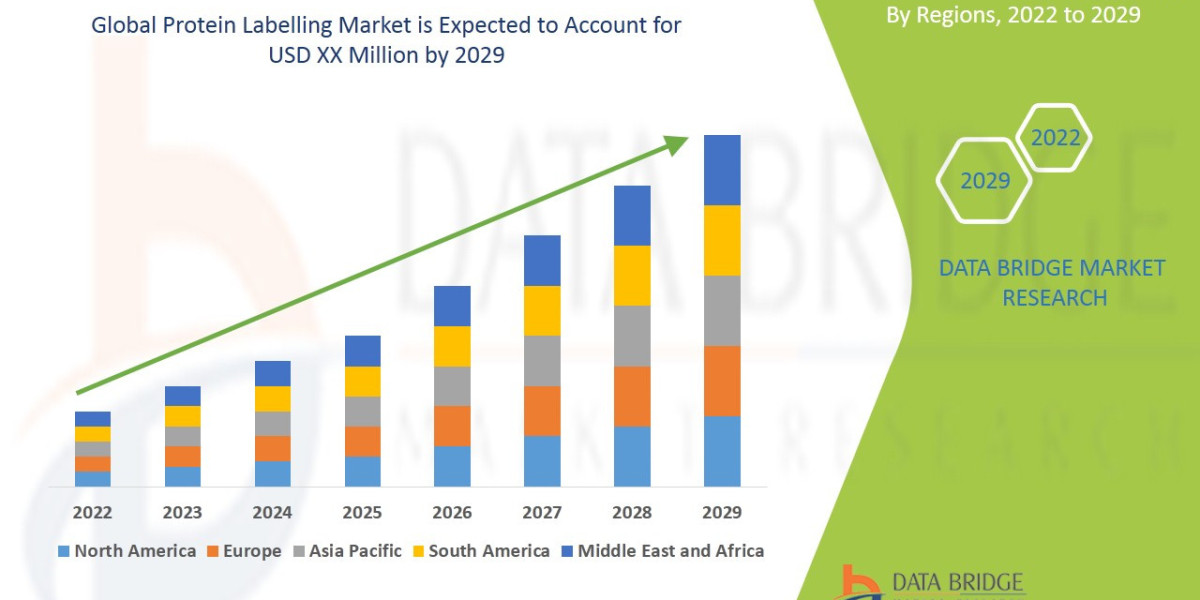"Protein Labelling Market – Industry Trends and Forecast to 2029
Global Protein Labelling Market, By Labelling Method (In Vitro Labelling, In Vivo Labelling and Biorthogonal Labelling), Product (Reagents, Kits and Services), Application (Immunological Techniques, Cell-Based Assays, Fluorescence Microscopy, Protein Microarrays and Mass Spectrometry), End User (Hospitals, Academic Institutes, Research Laboratories and Diagnostic Centres), Country (U.S., Canada, Mexico, Germany, Italy, U.K., France, Spain, Netherland, Belgium, Switzerland, Turkey, Russia, Rest of Europe, Japan, China, India, South Korea, Australia, Singapore, Malaysia, Thailand, Indonesia, Philippines, Rest of Asia- Pacific, Brazil, Argentina, Rest of South America, South Africa, Saudi Arabia, UAE, Egypt, Israel, Rest of Middle East and Africa) Industry Trends and Forecast to 2029
Access Full 350 Pages PDF Report @
https://www.databridgemarketresearch.com/reports/global-protein-labelling-market
**Segments**
- **By Product**: The protein labelling market can be segmented into Reagents & Kits and Services. Reagents & Kits are further divided into Dyes, Fluorescent Proteins, Probes/Tags, and Other Reagents & Kits.
- **By Labelling Method**: The market can be categorized into In Vitro Labelling and In Vivo Labelling. In Vitro Labelling includes Enzymatic Labeling, Dye-based Labeling, Co-translational Labeling, and Bio-orthogonal Labeling. On the other hand, In Vivo Labelling comprises Radioactive Labeling, MR Imaging, X-ray CT, and Optical Imaging.
- **By Application**: Protein labelling finds applications in Cell-based Assays, Fluorescence Microscopy, Immunological Techniques, Mass Spectrometry, Protein Microarray, and other applications such as Protein Purification and Analysis.
**Market Players**
- Thermo Fisher Scientific Inc.
- Merck KGaA
- PerkinElmer Inc.
- General Electric Company
- Kaneka Corporation
- LI-COR, Inc.
- Promega Corporation
- F. Hoffmann-La Roche Ltd
- Kirkegaard & Perry Laboratories (KPL)
- Seracare Life Sciences
- Jena Bioscience GmbH
- Prometic Life Sciences Inc.
The protein labelling market is experiencing significant growth driven by the increasing adoption of protein labelling techniques in various applications such as drug discovery, proteomics, and diagnostics. The demand for protein labelling reagents and kits is on the rise due to the growing research activities in the pharmaceutical and biotechnology sectors. The availability of advanced labelling methods such as bio-orthogonal labelling and optical imaging is also contributing to market expansion. Furthermore, the rising focus on personalized medicine and the development of novel bioconjugates are expected to propel market growth in the coming years.
In terms of product segmentation, the reagents & kits segment dominates theThe protein labelling market is witnessing robust growth due to the increasing demand for protein labelling techniques across various applications in the pharmaceutical, biotechnology, and research sectors. Reagents & kits segment holds a significant share, driven by the rising adoption of protein labelling reagents for cell-based assays, fluorescence microscopy, protein microarray, mass spectrometry, and other applications. Dyes, fluorescent proteins, probes/tags, and other reagents & kits are key components of this segment, catering to the diverse labelling requirements of researchers and scientists.
Furthermore, services segment play a crucial role in the protein labelling market, offering specialized labelling methods such as enzymatic labelling, co-translational labelling, bio-orthogonal labelling, radioactive labelling, MR imaging, X-ray CT, and optical imaging. These services provide valuable support to researchers in labeling proteins for in vitro and in vivo applications, enabling them to study protein-protein interactions, cellular processes, and disease mechanisms with high precision and accuracy.
The market players in the protein labelling industry such as Thermo Fisher Scientific Inc., Merck KGaA, PerkinElmer Inc., General Electric Company, and others are focusing on product innovation, strategic collaborations, and acquisitions to strengthen their market position and expand their product offerings. For instance, Thermo Fisher Scientific Inc. offers a wide range of protein labelling reagents and kits for various applications, catering to the evolving needs of researchers and clinicians in the life sciences domain.
The increasing focus on personalized medicine and the development of novel bioconjugates are driving the demand for advanced protein labelling techniques and services. Personalized medicine requires precise and targeted protein labelling methods to diagnose diseases, monitor treatment responses, and develop personalized therapies for patients. This necessitates the utilization of innovative labelling technologies such as bio-orthogonal labelling and optical imaging, which offer high specificity, sensitivity, and multiplexing capabilities for protein detection and quantification.
Moreover, the integration**Global Protein Labelling Market**
- **By Labelling Method**: In Vitro Labelling, In Vivo Labelling, Biorthogonal Labelling
- **Product**: Reagents, Kits, Services
- **Application**: Immunological Techniques, Cell-Based Assays, Fluorescence Microscopy, Protein Microarrays, Mass Spectrometry
- **End User**: Hospitals, Academic Institutes, Research Laboratories, Diagnostic Centres
- **Country**: U.S., Canada, Mexico, Germany, Italy, U.K., France, Spain, Netherland, Belgium, Switzerland, Turkey, Russia, Rest of Europe, Japan, China, India, South Korea, Australia, Singapore, Malaysia, Thailand, Indonesia, Philippines, Rest of Asia-Pacific, Brazil, Argentina, Rest of South America, South Africa, Saudi Arabia, UAE, Egypt, Israel, Rest of Middle East and Africa
The global protein labelling market is witnessing substantial growth, driven by the increasing adoption of protein labelling techniques across diverse applications in the pharmaceutical, biotechnology, and research sectors. The market is segmented by labelling method, including in vitro labelling, in vivo labelling, and biorthogonal labelling, catering to the varied needs of researchers in protein-protein interaction studies, disease mechanisms, and cellular processes analysis. The product segment comprises reagents, kits, and services, with reagents and kits being the primary revenue generator due to the rising demand for protein labelling reagents in cell-based assays
The report provides insights on the following pointers:
- Market Penetration: Comprehensive information on the product portfolios of the top players in the Protein Labelling Market.
- Product Development/Innovation: Detailed insights on the upcoming technologies, R&D activities, and product launches in the market.
- Competitive Assessment: In-depth assessment of the market strategies, geographic and business segments of the leading players in the market.
- Market Development: Comprehensive information about emerging markets. This report analyzes the market for various segments across geographies.
- Market Diversification: Exhaustive information about new products, untapped geographies, recent developments, and investments in the Protein Labelling Market.
Global Protein Labelling Market survey report analyses the general market conditions such as product price, profit, capacity, production, supply, demand, and market growth rate which supports businesses on deciding upon several strategies. Furthermore, big sample sizes have been utilized for the data collection in this business report which suits the necessities of small, medium as well as large size of businesses. The report explains the moves of top market players and brands that range from developments, products launches, acquisitions, mergers, joint ventures, trending innovation and business policies.
The following are the regions covered in this report.
- North America [U.S., Canada, Mexico]
- Europe [Germany, UK, France, Italy, Rest of Europe]
- Asia-Pacific [China, India, Japan, South Korea, Southeast Asia, Australia, Rest of Asia Pacific]
- South America [Brazil, Argentina, Rest of Latin America]
- The Middle East & Africa [GCC, North Africa, South Africa, Rest of the Middle East and Africa]
This study answers to the below key questions:
- What are the key factors driving the Protein Labelling Market?
- What are the challenges to market growth?
- Who are the key players in the Protein Labelling Market?
- What are the market opportunities and threats faced by the key players?
Commercial Drones Market
Composite Materials Market
Dental Prosthetics Market
Orthopedic Extremity Devices Market
Household Cooking Appliances Market
Kidney Pancreas Transplant Market
Allograft Market
Infection Surveillance Solutions Systems Market
Non Clinical Homecare Software Market
Water Softeners Market
Hydrophilic And Hydrophobic Coatings Market
Reflective Films Packaging Market
Diaphragm Valves Market
Prothrombin Time Testing Market
Fractional Flow Reserve Market
Immunodiagnostics Market
Semiconductor Ip Market
Automotive Heat Exchanger Market
Aluminium Composite Panels Market
First Aid Kit Packaging Market
About Data Bridge Market Research:
Data Bridge set forth itself as an unconventional and neoteric Market research and consulting firm with unparalleled level of resilience and integrated approaches. We are determined to unearth the best market opportunities and foster efficient information for your business to thrive in the market. Data Bridge endeavors to provide appropriate solutions to the complex business challenges and initiates an effortless decision-making process.
Contact Us:
Data Bridge Market Research
US: +1 614 591 3140
UK: +44 845 154 9652
APAC : +653 1251 975






